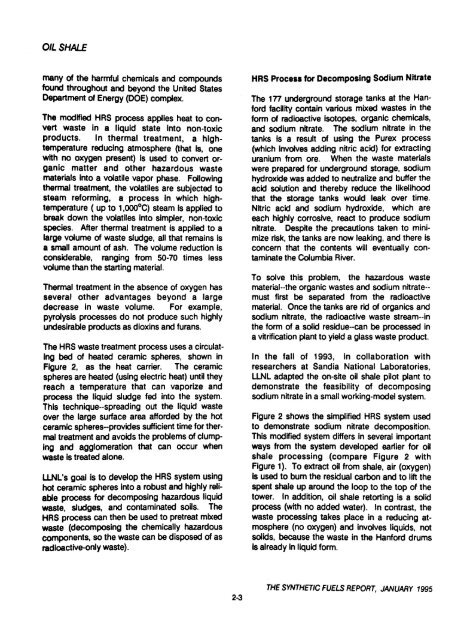Ikelic - Alliance Digital Repository
Ikelic - Alliance Digital Repository
Ikelic - Alliance Digital Repository
Create successful ePaper yourself
Turn your PDF publications into a flip-book with our unique Google optimized e-Paper software.
OIL SHALE<br />
many of the harmful chemicals and compounds<br />
found throughout and beyond the United States<br />
Department of Energy (DOE) complex.<br />
The modified HRS process applies heat to con<br />
vert waste in a liquid state into non-toxic<br />
products. In thermal treatment, a high-<br />
temperature reducing atmosphere (that is, one<br />
with no oxygen present) is used to convert or<br />
ganic matter and other hazardous waste<br />
materials into a volatile vapor phase. Following<br />
thermal treatment, the volatiles are subjected to<br />
steam reforming, a process in which high-<br />
temperature ( up to 1,000C) steam is applied to<br />
break down the volatiles into simpler, non-toxic<br />
species. After thermal treatment is applied to a<br />
large volume of waste sludge, all that remains is<br />
a small amount of ash. The volume reduction is<br />
considerable, ranging<br />
volume than the starting material.<br />
from 50-70 times less<br />
Thermal treatment in the absence of oxygen has<br />
several other advantages beyond a large<br />
decrease in waste volume. For example,<br />
pyrolysis processes do not produce such highly<br />
undesirable products as dioxins and furans.<br />
The HRS waste treatment process uses a circulat<br />
ing bed of heated ceramic spheres, shown in<br />
Figure 2, as the heat carrier. The ceramic<br />
spheres are heated (using electric heat) until they<br />
reach a temperature that can vaporize and<br />
process the liquid sludge fed into the system.<br />
This technique-spreading<br />
out the liquid waste<br />
over the large surface area afforded by the hot<br />
ceramic spheres-provides sufficient time for ther<br />
mal treatment and avoids the problems of clump<br />
ing<br />
and agglomeration that can occur when<br />
waste is treated alone.<br />
LLNL's goal is to develop the HRS system using<br />
hot ceramic spheres into a robust and highly reli<br />
able process for decomposing hazardous liquid<br />
waste, sludges, and contaminated soils. The<br />
HRS process can then be used to pretreat mixed<br />
waste (decomposing the chemically hazardous<br />
components, so the waste can be disposed of as<br />
radioactive-only waste).<br />
2-3<br />
HRS Process for Decomposing Sodium Nitrate<br />
The 177 underground storage tanks at the Han<br />
ford facility contain various mixed wastes in the<br />
form of radioactive isotopes, organic chemicals,<br />
and sodium nitrate. The sodium nitrate in the<br />
tanks is a result of using the Purex process<br />
(which involves adding nitric acid) for extracting<br />
uranium from ore. When the waste materials<br />
were prepared for underground storage, sodium<br />
hydroxide was added to neutralize and buffer the<br />
acid solution and thereby reduce the likelihood<br />
that the storage tanks would leak over time.<br />
Nitric acid and sodium hydroxide,<br />
which are<br />
each highly corrosive, react to produce sodium<br />
nitrate. Despite the precautions taken to mini<br />
mize risk, the tanks are now leaking, and there is<br />
concern that the contents will eventually con<br />
taminate the Columbia River.<br />
To solve this problem, the hazardous waste<br />
material-the organic wastes and sodium nrtrate-<br />
must first be separated from the radioactive<br />
material. Once the tanks are rid of organics and<br />
sodium nitrate, the radioactive waste stream-in<br />
the form of a solid residue-can be processed in<br />
a vitrification plant to yield a glass waste product.<br />
In the fall of 1993, in collaboration with<br />
researchers at Sandia National Laboratories,<br />
LLNL adapted the on-site oil shale pilot plant to<br />
demonstrate the feasibility of decomposing<br />
sodium nitrate in a small working-model system.<br />
Figure 2 shows the simplified HRS system used<br />
to demonstrate sodium nitrate decomposition.<br />
This modified system differs in several important<br />
ways from the system developed earlier for oil<br />
shale processing (compare Figure 2 with<br />
Figure 1). To extract oil from shale, air (oxygen)<br />
is used to bum the residual carbon and to lift the<br />
spent shale up around the loop to the top of the<br />
tower. In addition, oil shale retorting is a solid<br />
process (with no added water). In contrast, the<br />
waste processing takes place in a reducing at<br />
mosphere (no oxygen) and involves liquids, not<br />
solids, because the waste in the Hanford drums<br />
is already in liquid form.<br />
THE SYNTHETIC FUELS REPORT, JANUARY 1995















![pace SrntfletIc fne]its report - Alliance Digital Repository](https://img.yumpu.com/10493335/1/190x245/pace-srntfletic-fneits-report-alliance-digital-repository.jpg?quality=85)
